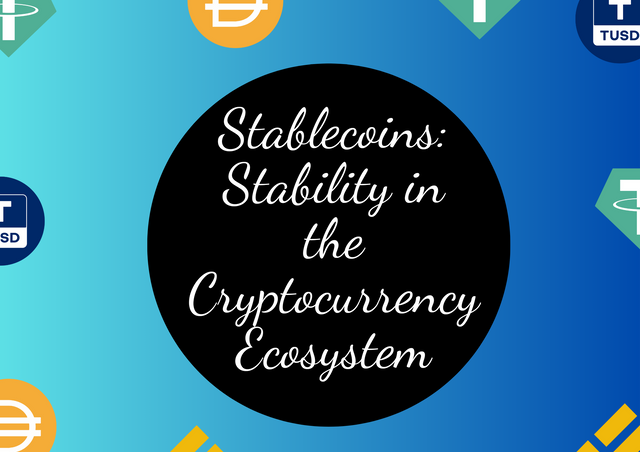Stablecoins: Stability in the Cryptocurrency Ecosystem
Introduction |
|---|
Stablecoins are a form of cryptocurrency intended to reduce price fluctuation. Stablecoins, as opposed to other cryptocurrencies such as Bitcoin or Ethereum, which can undergo large price volatility, are expressly designed to maintain a consistent value relative to a specific item or a basket of assets. Stablecoins' principal objective is to serve as a more trustworthy means of exchange and a store of value inside the bitcoin ecosystem.

Made With Canva
Stablecoins attain their stability through a variety of techniques. Pegged or collateralized stablecoins are the most frequent types of stablecoins. Pegged stablecoins are coins that are directly linked to an underlying asset, such as a fiat currency such as the US dollar or a commodity such as gold. These stablecoins keep their value by storing reserves of the underlying asset in a bank account or via smart contracts. While, algorithmic stablecoins, which use complex algorithms and smart contracts to guarantee price stability, are another sort of stablecoin. Stablecoins rely on mechanisms such as supply adjustments, incentivized trade, and algorithmic rebalancing to maintain their value.
Why were stablecoins created and how are they useful? |
|---|
Stablecoins were developed in response to the price volatility associated with existing cryptocurrencies such as Bitcoin and Ethereum. These cryptocurrencies' severe price volatility make them less viable for regular transactions and impede their adoption as a dependable means of exchange and store of wealth. Here are some of the reasons for the creation of stablecoins and how they might be useful:
Stability:- Stablecoins' primary objective is to bring stability in the turbulent cryptocurrency market. Stablecoins provide a predictable and consistent value that may be utilised for day-to-day transactions by maintaining a steady value compared to an underlying asset or a basket of assets. Because of their stability, they are more suited for usage in e-commerce, remittances, and other financial applications.
Easy Conversion:- Stablecoins allow for the quick and easy conversion of traditional fiat currency to cryptocurrencies. Because stablecoins are often tied to a fiat currency, such as the US dollar, they can serve as a link between the existing financial system and the world of cryptocurrencies. Users can change their funds into stablecoins and store them securely, minimising the need for regular transfers between cryptocurrencies and fiat currencies.

From Pexels
Global Accessibility:- Stablecoins improve global access to financial services. They can traverse borders more swiftly and at a cheaper cost than traditional means. Stablecoins are thus useful for remittances, in which individuals can transmit payments to family members in various countries without the need for intermediaries or incurring hefty costs.
Decentralized Finance (DeFi):- Stablecoins are an important component of the burgeoning field of decentralised finance. Within many DeFi apps, they serve as a solid unit of account and a medium of exchange. Stablecoins let users to earn interest on their holdings, contribute liquidity to decentralised exchanges, and participate in other decentralised financial activities.
Hedging and Risk Management:- Stablecoins can be used to protect against the volatility of other cryptocurrencies. Traders and investors can use stablecoins to protect the value of their portfolio during moments of significant market volatility. During market downturns, stablecoins provide a stable asset to retain money and limit risk exposure.
What are the most popular stablecoins? Which do you use more and why? |
|---|
Here are some of the most popular stablecoins I know:-
Tether (USDT):- Tether is one of the most established and extensively used stablecoins. It is issued on many blockchain systems, including Ethereum, and is supposed to be pegged to the US dollar at a 1:1 ratio. Tether has been the subject of some controversy and regulatory attention due to its lack of transparency and reserve backing, yet it is still widely traded and integrated into numerous cryptocurrency exchanges and platforms.
USD Coin (USDC):- USD Coin is another well-known stablecoin that was launched by Circle and Coinbase. It uses the Ethereum blockchain to ensure transparency and regulatory compliance. USDC is backed by US dollar reserves maintained in a bank account, and it has gained popularity in a variety of decentralised finance (DeFi) apps and exchanges.

Made With Canva
Binance USD (BUSD):- Binance USD is a stablecoin created by Binance, a cryptocurrency exchange. It is based on the Binance Chain and is tied to the US dollar. BUSD is a trading pair on the Binance exchange that attempts to promote transparency and regulatory compliance.
Dai (DAI):- The Dai is, a decentralised stablecoin built on the Ethereum network. Dai achieves stability through a system of collateralized debt positions (CDPs) and autonomous feedback mechanisms, as opposed to other stablecoins that rely on a centralised body or reserve. It is widely utilised in lending, borrowing, and other decentralised financial applications within the DeFi ecosystem.
But among these I preferred and usually use USDT as my primary stable coin. Secondly, I prefer BUSD except these two I don't use any other stable coins for any transaction or trading.
Can stablecoins lose their stability? |
|---|
Yes, stablecoins can lose their stability, while stablecoin issuers and processes normally strive to preserve a stable value. Various circumstances, however, can contribute to the lack of stability in stablecoins:
Counterparty Risk:- Stablecoins that rely on a single organisation to store reserves or oversee operations may be vulnerable to counterparty risk. If the entity experiences financial difficulties, mismanagement, or fails to maintain adequate reserves, the stablecoin may lose its stability.
Insufficient Collateralization:- Collateralized stablecoins rely on a sufficient reserve of assets to support the stablecoin's value. If the collateral's value falls dramatically, the stablecoin's stability may be jeopardised. This can happen during periods of high market volatility, or if the collateral is exposed to regulatory changes or unanticipated events.

From Pixabay
Regulatory Challenges:- Stablecoins are subject to regulatory scrutiny and possible regulatory changes, which can have an impact on their stability. If regulatory authorities impose limits, require additional compliance requirements, or question stablecoin reserve holdings, it can cause uncertainty and undermine their stability.
Liquidity Constraints:- Stablecoins require adequate liquidity to remain stable. A lack of liquidity or insufficient trading volume in the market can cause price variations and difficulties in maintaining market stability.
Systemic Risks:- Some stablecoins' stability can be linked to the larger cryptocurrency ecosystem. Stablecoins may be harmed and lose stability if there are systemic concerns or large market disruptions affecting the cryptocurrency market as a whole.
Conclusion |
|---|
Stablecoins are made to counter the volatility among crypto market and they are stability is determined by two things one if it is either pegged with some stable collaterals like gold or US dollar or by smart contracts. Stablecoins have many positive aspects and it is known for it's stability, easy convertion and global accessibility feature but everything have a negative point as well and here the negative thing is it also can crash for various reason, so we have to very careful while investing or holding money in these stable coins as well.
https://twitter.com/SibanandaMaha14/status/1661714587375505408?t=rOMUDVsQms6o0fHXSgj9uw&s=19